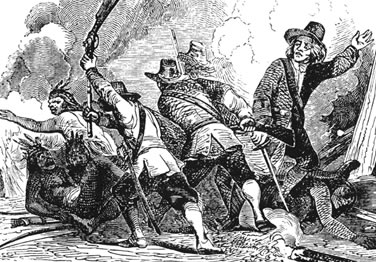Name/Location
The name "Pequot" is thought to mean "the destroyers" in Algonquin language. They lived in moden-day Connecticut.
The Pequots were an agricultural community and cultivated corn, beans, tobacco, and squash. They also hunted and caught fish and seafood.
The Pequots lived in wigwams or medium-sized longhouses. Wigwams are small houses, usually eight to ten feet high, made of wooden frames and covered with mats. A longhouse, more often associated with the Iroquois, was a house made of wooden poles that was designed to house up to 20 families.
Unlike their Naragansett and Wampanoag neighbors, the Pequots were a war-like people that dominated Connecticut until colonization. They were highly structured with a strong central authority system that rested with the tribal council and the grand sachem.

Pequot War
The Pequots were thought to be indigenous to eastern and central Connecticut. In the early 1600's, one of the Pequot sachems, named Uncas, became dissatisfied with the rule of Sassacus, the Grand Sachem, and broke off to form his own tribe, which became the Mohegans. The Mohegans, unlike the Pequots, would become allies of the colonists. Nevertheless, the Pequots remained a large tribe and probably numbered about 16,000, until a deadly epidemic killed nearly 80 percent of the population in 1633. Shortly after the epidemic, English colonization of the Pequot lands moved at a frantic pace and eventually resulted in small-scale conflicts and attacks (coordinated by both the Indians and the English settlers at Fort Saybrook) that escalated into the Pequot War. As other local tribes such as the Naragansett and Mohegan made alliances with the English, the Pequots lashed out. Pequot warriors, who had previously attacked a group of Mattabesic Indians who had tried to trade with colonists, had begun killing English settlers who ventured outside of their stronghold at Fort Saybrook. Connecticut colonial leaders, together with their Naragansett allies, soon devised a strategy to combat the Pequots and massacred the largest Pequot Village at Misistuck, burning it to the ground and killing almost 700 Pequots, most of whom were women and children. The grizzly scene became known throughout history as the Massacre at Mystic. 180 Pequot warriors were subsequently killed when they were found hiding in a swamp near Fairfield. Many were captured and sold as slaves. The Pequots never recovered from the war and were virtually annihilated.
Today, the Pequots operate Foxwoods Casino, the world's largest resort casino, on their 1,800 acre reservation in Connecticut. The Pequots have used revenues from the casino to expand their reservation and have built a cultural museum called the Mashantucket Pequot Museum and Research Center, which details the history of the Pequot nation.